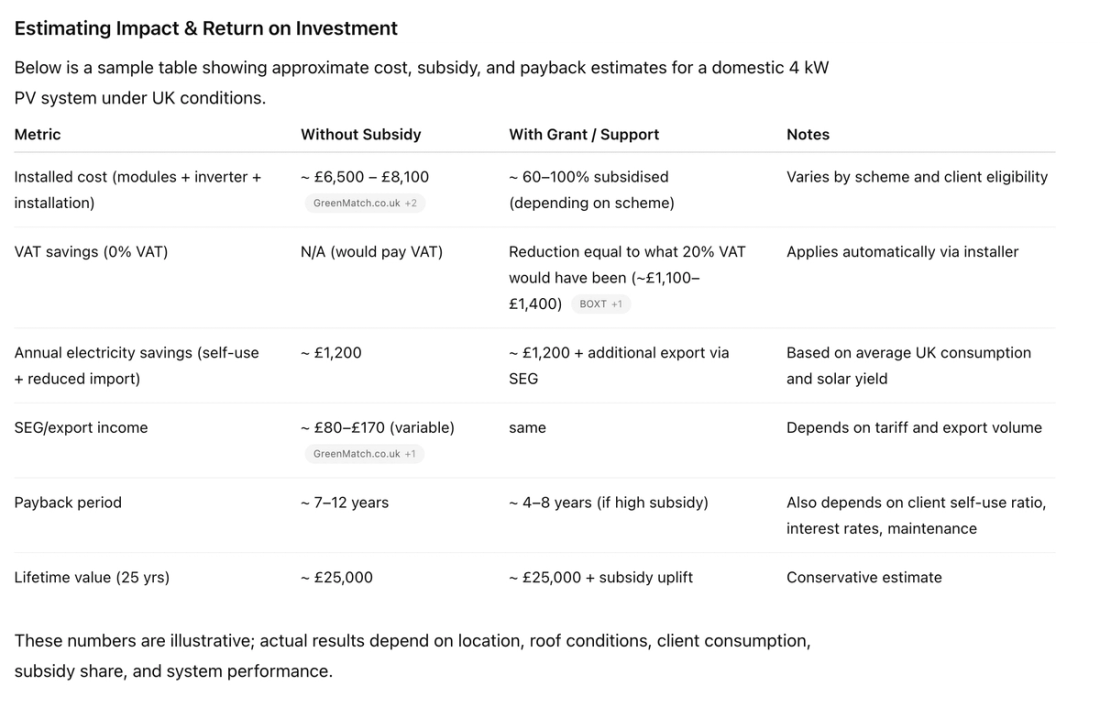Introduction
In the UK, the concept of a solar panel grant remains highly relevant for homeowners and businesses aiming to adopt renewable energy with lower upfront cost. However, the landscape is complex: grants are seldom “pure solar-only” subsidies, eligibility rules vary by region, income levels, and energy performance, and installers and project managers must navigate a patchwork of schemes, compliance obligations, and financing models.
In this article, we break down the current solar funding environment in the UK (2025), clarify which programmes qualify as grants, explain how installers and engineers can structure proposals to maximise client uptake, and offer best practices and case-based recommendations. Whether you are designing a commercial rooftop PV array or proposing domestic systems, you’ll find actionable insights to improve project viability, reduce client risk, and position your offerings more competitively.
The UK Solar Grant Landscape (2025)
The UK government no longer supports large-scale feed-in tariffs or blanket grants for residential solar installations.Instead, most support today comes via broader energy efficiency or low-income schemes rather than direct solar panel grants.
Key instruments currently include:
- ECO4 scheme (Energy Company Obligation 4): A government-backed programme running until March 2026, designed to support low-income and low-EPC (D, E, F, G) households in making energy-saving improvements. Solar PV is included among eligible measures in certain cases.
- LA Flex / Local Authority Flexibility (within ECO4): Councils have discretion to relax eligibility criteria in their jurisdiction (i.e. beyond just benefit recipients).
- Warm Homes: Local Grants: In England, this scheme allows eligible households (low income, lower EPC rating) to receive free home efficiency improvements arranged via local council funding — potentially including solar panels.
- 0% VAT on solar panel materials & installation: From 1 April 2022 until March 2027, the UK applies 0% VAT on qualifying energy-saving materials including solar PV (but not always batteries) — effectively reducing cost directly.
- Smart Export Guarantee (SEG): While not a grant, SEG enables owners of small-scale generation (e.g. solar PV) to be paid for electricity they export to the grid — which improves project paybacks and can influence design decisions.
Because of this structure, one cannot reliably pitch “a solar panel grant” to all clients; instead, the term often refers to obtaining subsidy or funding via one of these energy-efficiency programmes.
Common Challenges for Installers & Engineers
Before designing a project around subsidy, professionals should be aware of several common hurdles:
- Eligibility constraints and means-testing
Many schemes (especially ECO4) require that the household is on certain benefits or falls below income thresholds. Even with LA Flex, local authorities may impose additional rules (e.g. earnings caps, number of occupants, health conditions). - EPC rating requirements & property conditions
Often, the property must have an Energy Performance Certificate (EPC) rating of D, E, F or G to qualify for intervention. If the home already rates highly (A–C), then funding for PV may be excluded. - Coordination with other measures
These programmes often bundle multiple energy-efficiency improvements (e.g. insulation, heat pumps, glazing). Solar PV may not always be the top priority or may compete for funding allocation. - Administrative overhead and compliance
Ensuring that your project meets all scheme requirements (certification, metering, product standards, auditing, reporting) adds cost and risk. The complexity of applying and documenting increases the burden on small installers. - Uncertainty of continuation and funding caps
Some schemes are temporary or limited by funding budgets, and may end unexpectedly, or councils may exhaust their local allocation. - Client education and skepticism
Many homeowners believe “all grants have ended” or are wary of misleading offers. Transparent demonstration of subsidy mechanics, contract terms, and fallback options is essential.
Practical Solutions & Best Practices
To navigate those challenges and deliver viable projects under “solar grant”-style funding, installers and engineers should adopt the following strategies:
1. Pre-qualification screening tool
Implement a pre-screen questionnaire for prospects, covering:
- Household income / benefit status
- EPC rating of property
- Ownership status & tenure
- Roof orientation, shading, structural suitability
This helps quickly triage which cases are viable for subsidy-based proposals.
2. Modular project proposals
Design system proposals with optional “grant-eligible package” and “standard package” tracks. If the property qualifies, present a subsidised version; otherwise fall back to conventional pricing. This avoids wasted time in chasing subsidy opportunities when a client is ineligible.
3. Bundle with higher-priority measures
In many funding programmes, insulation, heat pumps, or glazing may rank higher in funding priority. Partnering or bundling PV with those improvements can help “piggyback” your proposal with more likely funded items.
4. Use of software and workflow automation
A robust platform or tool (like Reonic) can automate eligibility checks, generate documentation, track compliance, and coordinate multiple measures. This reduces manual error and administrative overhead.
5. Local authority engagement
Stay closely connected with your local councils and scheme administrators. Understand their LA Flex criteria, funding cycles, and documentation expectations. Early communication can allow you to adapt proposals to local priorities.
6. Contingency clauses & client transparency
Because funding may be delayed, reduced, or denied, include fallback clauses: e.g. “if grant is not confirmed, client pays difference” or “project proceeds without funding.” Document risks clearly so clients understand the caveats.
Example Case Studies
Case Study A: Semi-detached home under ECO4
A homeowner in the Midlands with an EPC rating of E and on Universal Credit approached a local MCS-certified installer. Screening showed eligibility for ECO4. The installer proposed a 4 kW PV system as part of a package including loft insulation and a smart heating controller. After survey and paperwork, ECO4 funding covered 80% of the PV cost. The homeowner paid the remaining 20%. The expected payback dropped from ~10 years to ~6.5 years, thanks to the subsidy and SEG export income.
Case Study B: Local council solar in social housing
A local authority running a Warm Homes Social Housing fund rolled out solar panels on dozens of social homes concurrently. Because scale lowered per-unit costs and risk was borne by the authority, installers could deploy standardized designs with minimal variation. Project managers used a software dashboard to coordinate installations, subsidy claims, and performance tracking.
Case Study C: Fallback for ineligible client
A client did not qualify for subsidy (too high income). The installer proposed the full-cost PV installation along with the client registering for SEG. To make it more attractive, the installer provided financing options (e.g. 0% APR for 5 years). The fallback approach allowed the installer to still win business while not outright rejecting the project.
Design & Planning Considerations under Grant-Based Projects
When the project is subsidy-backed or expected to rely on grant eligibility, further constraints and design refinements come into play:
- Component certification & standards
Use only equipment approved under MCS or equivalent schemes. The module, inverter, mounting, metering must comply with scheme requirements. - Metering & export measurement
Ensure correct export metering (smart export measurements) so that SEG payments are traceable. Some schemes may require half-hourly export metering. - Prioritise self-consumption
Given constraint on export tariffs, maximize self-use of generated electricity (e.g. with smart loads, battery, or diverters) to boost internal value rather than relying on export payments. - Roof orientation & shading optimization
As always, orient systems to east/south/west, minimize shading, and consider module-level optimisers in constrained layouts. But in subsidy projects, you may need to justify your layout to scheme assessors. Provide shading analysis diagrams or simulation outputs. - Staging & scalability
Because budgets may limit full installation, propose phased steps (e.g. portion PV now, expand later) with optional client contributions, while preserving scheme compliance. - Performance guarantees & warranties
Especially in subsidised projects, clients expect robust guarantees. Provide 25-year warranties, monitoring, maintenance plans, and performance guarantees to reduce perceived risk.

How Reonic Can Help Professionals
While this article does not aim to be promotional, it is worth noting how a flexible renewable energy software platform (e.g. Reonic) can support professionals in delivering grant-informed solar projects:
- Eligibility automation: built-in filters to screen leads for subsidy eligibility (income, benefits, EPC)
- Document generation: auto-generate compliance forms, grant submission documents, client disclosure templates
- Project tracking & reporting: dashboards that monitor subsidy status, install progress, performance, and audit logs
- Multi-measure coordination: ability to design combined measures (PV + insulation + heat pump) under a single proposal
- Client communications & transparency: templated client-facing reports showing subsidy impacts, fallback options, and guarantees
Such tools reduce administrative friction, errors, and cycle times — making subsidy-driven solar projects more scalable and profitable.
Conclusion
In 2025, UK “solar panel grants” do still exist — but mostly within broader energy efficiency or low-income schemes rather than pure solar-only subsidies. For installers, engineers, and project managers, succeeding in this environment demands:
- rigorous pre-screening of clients for subsidy eligibility
- modular proposals that can adapt to subsidy or non-subsidy paths
- integration with multiple energy-efficiency measures
- strong compliance, documentation, and monitoring workflows
- clear client communication and fallback mechanisms
By aligning your project process with subsidy schemes (like ECO4, LA Flex, Warm Homes) and leveraging automation or software platforms, you can unlock more deals, reduce client cost, and differentiate your offering.
In an era where energy costs remain volatile and the push for decarbonisation intensifies, being subsidy-literate is a strategic advantage for renewable professionals.
FAQ — Solar Panel Grant (UK)
Q1: Is there still a solar panel grant in the UK in 2025?
A: There is no universal, solar-only grant scheme. Instead, solar panels are eligible under broader programmes (ECO4, Warm Homes, etc.).
Q2: Who qualifies for solar funding under ECO4?
A: Typically, households on certain benefits, with lower income, and homes with EPC ratings of D or worse. Local Authority Flexibility (LA Flex) can open eligibility further in some areas.
Q3: How do I apply for a solar grant or funding?
A: Usually via an approved installer or energy supplier participating in the scheme. The installer organizes a survey, compliance checks, and funding submissions. Clients typically do not apply directly.
Q4: Does the 0% VAT always apply to solar panels?
A: It applies until March 2027 for qualifying energy-saving materials and installations, including solar panels (but not always batteries). The installer should apply it automatically if eligible.
Q5: What is the Smart Export Guarantee (SEG)?
A: SEG is a scheme requiring electricity suppliers to purchase surplus electricity exported to the grid from small-scale generators (like rooftop PV). The rate varies, and consumers need a smart meter.
Q6: Can tenants or landlords benefit from solar grants?
A: It depends on property tenure and scheme rules. Some schemes exclude houses-in-multiple-occupation or rented properties; others require landlord consent. Always check local scheme details.
Q7: What happens if the grant is withdrawn mid-project?
A: You should include a fallback clause in contracts — e.g. client covers difference, or project scales back. Transparent communication of risk is essential.
Q8: How long does a subsidised solar project pay back?
A: It depends on subsidy share, location, consumption, and export tariffs. With strong funding, payback may fall to 4–8 years; without, 7–12+ years is more typical.







